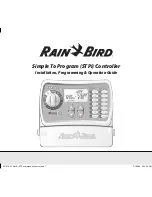
Page 41
©
2012 Magnum Energy, Inc.
Installation
Conductors and General Wiring Methods
Conductors are rated for the application and the environment.
Standard building-wire conductors and appropriate wiring methods are used.
Note: Welding, marine, locomotive (DLO), and auto battery cables don’t meet NEC/CEC
requirements. Flexible RHW or THW cables are available, but these cables require very limited,
specially listed terminals. When the battery conductors leave the battery enclosure, the conductors
must be of a type listed for use in conduit (RHW or THW).
The DC and AC color codes for the ground conductors are the same – grounded conductors
are white and equipment-grounding conductors are green, green/yellow, or bare (no insulation).
All wiring insulation must have a minimum rating of 150V, 75°C when using only 120 VAC
power/inverter; or, with a minimum rating of 300V, 75°C when using 120/240 VAC power/inverter.
Strain reliefs/cable clamps or conduit are used on all cables and cords.
Conductors between the inverter and battery bank are required to be installed in conduit.
No multi-wire branch circuits when single, 120 VAC inverters are connected to 120/240 VAC
load centers.
Note:
A multi-wire branch circuit is a three-wire circuit with a shared neutral for two, 120 VAC
branch circuits.
Overcurrent Protection
Properly sized and rated disconnects and overcurrent devices are used in the ungrounded
conductors in each circuit (AC and DC).
Overcurrent devices in the DC circuits are listed for DC operation.
DC overcurrent protection is provided at the batteries when they are located in a separate room,
or more than
fi
ve feet away from the MMP enclosure.
The DC overcurrent protection device and battery cables to the inverter are sized for the
inverter’s DC input current.
Note:
Inverter’s DC input current is calculated using rated AC output in watts, divided by lowest
battery voltage, divided by inverter effi ciency at that power level.
When the DC disconnect inside the MMP enclosure is not used as the DC overcurrent device,
high interrupt, listed, DC-rated fuses or circuit breakers must be used in the battery cable circuits.
Batteries
Battery terminals and other live parts are guarded, and adequate working space around the
battery bank is provided.
Batteries are installed in well-vented areas (garages, outbuildings) and not in living areas.
Adhere to the “IMPORTANT BATTERY SAFETY INSTRUCTIONS” at the beginning of this manual.
Marking
Battery bank is labeled with maximum operating voltage, equalization voltage, and polarity.
Utility Back-up Systems: a visible exterior sign indicating the building contains an inverter back-
up system and identi
fi
es the locations of the disconnects.
An electrical system supplied by a 120 VAC only inverter must include a label warning against
connecting multi-wire branch circuits.
All required “WARNING” and “CAUTION” signs are installed in the proper locations, as required
in the NEC/CEC.
Inspection
Electrical inspection complete and Certi
fi
cate of Electrical Inspection issued by the local Authority
Having Jurisdiction (AHJ). The local AHJ or inspector has the
fi
nal say on what is or is not acceptable.
Local codes may modify the requirements of the NEC/CEC.
Part of this checklist is obtained from the Photovoltaic Electrical Power Systems Inspector/Installer Checklist
created by John Wiles, Southwest Technology Development Institute, New Mexico State University, June, 2006.
Содержание Mini Magnum Panel
Страница 1: ...Mini Magnum Panel MMP Owner s Manual ...
















































